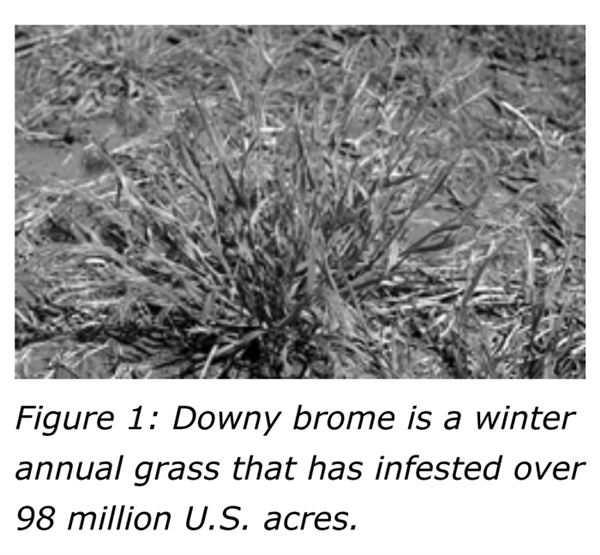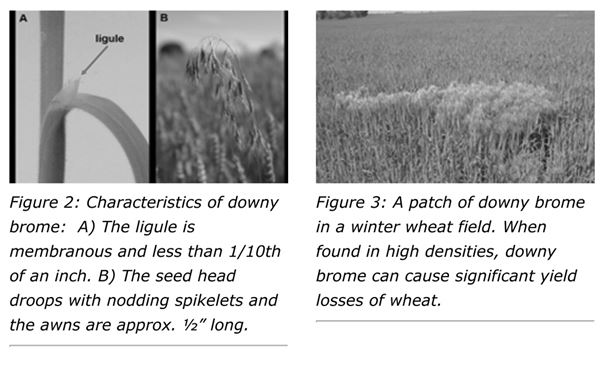|
Downy Brome: Don’t Let It Creep Up On You This Fall
DR. MANDY D. BISH AND DR. KEVIN BRADLEY
COLUMBIA, MO.
Downy brome (Bromus tectorum) is a winter annual grass that was introduced into the U.S. from Europe in the 1800’s through a contaminated shipment of grain. Now this pest (Figure 1) is found throughout North America and is classified as a noxious weed in Colorado and Connecticut. Downy brome is most problematic in winter wheat fields and pastures, and, as of 2000, had infested over 98 million acres of U.S. rangeland1.

The grass typically germinates in the fall, overwinters in the vegetative state, and resumes growth in early spring2. The leaf sheaths and blades of downy brome are generally light green in color and densely covered with soft hairs. The leaves are rolled in the shoot, lack auricles and have membranous ligules that are usually less than 1/10th of an inch in length (Figure 2A). The seed head (or panicle) is dense, soft, and droops with nodding spikelets. The awns on each seed are approximately ½” long (Figure 2B). Downy brome can be confused with cheat in appearance and growth habit; however, the leaf blades of cheat usually have fewer hairs, and the awns on the seed are shorter.
The life cycle of this grass makes it competitive with winter wheat (Figure 3). Studies have shown that downy brome densities of 108 and 538 plants per meter squared reduced wheat yields by 40 and 92 percent, respectively3. Under ideal conditions this pest may produce over 400 lb of seed per acre2; replenishing the weed seed bank for the next season.

Downy brome can sometimes emerge prior to wheat planting in Missouri, so if at all possible wheat producers should take advantage of this weakness and apply an effective burndown (usually containing glyphosate) herbicide treatment prior to planting. If downy brome emerges after wheat has been planted, herbicide applications should be made in the fall on small (preferably 2-leaf) plants. Some of the more effective herbicides for the control of this species include Maverick, Olympus Flex, and PowerFlex HL. Of the 3, PowerfFlex HL has the least restrictive crop rotational interval following application. It should be noted that downy brome with resistance to Group 2 herbicides (ALS inhibitors) including sulfosulfuron (Maverick) was reported in Kentucky4 in 1997 and downy brome with resistance to Group 1 (ACCase inhibitors) was reported in Oregon in 20054.
In pastures or haylands, young or immature downy brome can make suitable forage, but when the plant matures, it becomes less palatable and the awns become stiff and can sometimes injure livestock. Additionally, the crude protein content of mature plants drops to less than 3 percent making this plant less ideal for grazing2. For control in pastures, a multi-pronged approach is recommended which includes establishing more aggressive grasses to outcompete downy brome and mechanical techniques such as fire, mowing and tillage. There are no selective herbicides available for the control of this grass in a tall fescue pasture or hayland, so spot treatment of small downy brome patches is one of the only options in these settings.
For more information on downy brome and other weeds, please visit our Web site: www.weedid.missouri.edu or download the free ID WEEDS app. For more information on the identification of grass weeds that are common in Missouri, purchase or download a free copy of: IPM 2014, Identifying Grass Seedlings: http://weedscience.missouri.edu/publications/ipm1024.pdf.
1DiTomaso, JM. (2000) Invasive weeds in rangelands: Species, impacts and management. Weed Science 48: 255-265.
2Morrow, LA. and Stahlman, PW. (1984) The history and distribution of downy brome (Bromus tectorum) in North America. North America Weed Science 32: supplement.
3Rydrych, DJ. And Muzik, TJ. (1968) Downy brome competition and control in dryland wheat. Agronomy Journal 60: 279-280.
4Heap, I. (2014) The international survey of herbicide resistant weeds. Online. Internet. Monday, October 13, 2014. Available: www.weedscience.com ∆
DR. MANDY D. BISH: Research Specialist, University of Missouri
DR. KEVIN BRADLEY: Associate Professor, University of Missouri
|
|